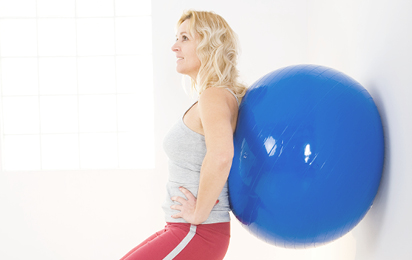3 Simple Ways to Help Prevent Knee Pain

The well-being of our knees and the muscles around them is essential for achieving and maintaining proper fitness levels, but they also happen to be one of the most problematic areas of the body. As the largest joint in the body, the knee takes on a great amount of impact in many of our daily activities—especially physically demanding tasks—and that’s one of the main reasons why knee pain is so common.
Knee pain can occur from a single, traumatic incident or it can develop gradually over time from a number of different causes. Anyone of just about any age can get knee pain, but those who are overweight, long-distance runners and athletes in sports that involve lots of jumping, cutting or pivoting like basketball, soccer and football are at a higher risk for experiencing it. In most cases this pain results from inflammation of one of the various structures that make up the knee after being worked too hard. Here are 3 simple tips to help prevent knee pain from developing:
Perform wall squats and hamstring curls three times a week
Strengthening the muscles that support your knee will alleviate overall stress on the joint, so it’s helpful to have stronger muscles in the front of your thigh (quadriceps) and back of your thigh (hamstrings) to absorb shock and reduce the chance of injury and pain.
To perform wall squats, which mainly work the quadriceps:
- Standing with an exercise ball in the mid-part of your back up against the wall, with feet hip-width apart; slowly slide down the wall until you are almost in a sitting position; the ball with roll up your back as you squat down; hold for 5-10 seconds, then slowly slide up; repeat for 10 repetitions. This can be done against the wall if you do not have an exercise ball.
For hamstring curls:
- Hold on to the back of a chair and plant your weight on your supporting leg; lift the other foot and bring the heel up toward your buttocks; hold for 3-5 seconds, then slowly lower your leg; repeat 10 times and then switch sides
Avoid habits that strain your knees
Certain activities and habits can add to the normal forces placed upon your knees and increase your risk for developing pain. Avoid too much time running uphill/downhill, climbing/descending stairs, and reduce your participation in high-impact sports or those with lots of jumping or changes in direction. If you’re a runner and you start to notice some pain, try changing up your routine with low-impact activities like swimming or biking instead. Also be sure to wear proper footwear with good arch support for all occasions, especially while exercising, and limit your time wearing high heels, ballet flats and flip-flops.
Maintain a healthy weight
Every extra pound you weigh puts additional strain on your knees, which increases the risk for injury and pain. That’s why if you’re overweight, one of the best possible things you can do for your knees is to make efforts to bring your weight down. Keeping a well-balanced, nutritious diet that’s high in fruits, vegetables and whole grains and low in added sugars and salt, and exercising on a regular basis are the most effective ways to lose pounds and reduce the stress on your knees to prevent pain from developing.










